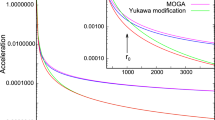Abstract
We have carried out numerical simulations of the dynamical evolution of galaxy clusters taking into account merging when the relative velocities of the colliding galaxies are low. In particular, we study the evolution of the structure, mass spectrum, and velocity spectrum of a cluster of a thousand galaxies, as well as the growth of the central supermassive cD galaxy. The initial velocity dispersion of the galaxies and the rotation of the cluster were taken into account. The observed logarithmic spectrum dN ∼ \(\tfrac{{dM}}{M}\) was adopted as the initial mass spectrum. The dynamical evolution of galaxy clusters, allowing for the possible merging of colliding galaxies, results in the emergence of a central supermassive galaxy, whose mass continuously increases due to mergers. This occurs only if the mass of the central galaxy becomes greater than ∼0.1 of the total mass of the cluster. The observation of cD galaxies with relative masses of ∼0.01 suggests that they initially formed in the cluster core, merged with nearby galaxies, and accreted intergalactic gas. The model indicates that a logarithmic galaxy mass spectrum is preserved during the cluster evolution, despite the substantial decrease in the number of galaxies in the cluster with time. The model can also reproduce the observed mass distribution with distance from the cluster center, M r ∼ r 1.7.
Similar content being viewed by others
References
J. Gallagher and J. Ostriker, Astron. J. 77, 288 (1972).
A. Garijo, G. Athanassoula, and C. Garcia-Comez, Astron. Astrophys. 327, 930 (1997).
R. Piffaretti and J. Kaastra, astro-ph/0602376 (2006).
W. Oegerle and J. Hill, Astron. J. 122, 2858 (2001).
B. Poggianti, astro-ph/0503212 (2005).
E. Egami, K. Misselt, G. Rieke, et al., astro-ph/0603656 (2006).
A. Hicks and R. Mushotzky, Astrophys. J. 635, L9 (2005).
B. Lanzoni, B. Guiderdoni, G. Mamon, et al., Mon. Not. R. Astron. Soc. 361, 369 (2005).
M. Nagashima, H. Yahagi, M. Enoki, et al., astro-ph/0508085 (2005).
W. Oegerle and J. Hill, Astron. J. 122, 2858 (2001).
A. Toomre and J. Toomre, Astrophys. J. 178, 623 (1972).
A. Gonzalez-Garcia and T. van Albada, astro-ph/0506014, 0506015 (2005).
J. Barnes and L. Hernguist, Astrophys. J. 471, 115 (1996).
K. Tran, P. van Dokkum, and M. Franx, et al., Astrophys. J. 627, L13 (2005).
C. Couselice, astro-ph/0507146 (2005).
J. Melbourne, S. Wright, M. Barczys, et al., Astrophys. J. 625, L27 (2005).
Y. Yamada, N. Arimoto, A. Vazdekis, et al., astro-ph/0511122 (2005).
P. Hopkins, L. Hernquist, T. Cox, et al., astro-ph/0506398 (2005).
D. Mast, R. Diaz, and M. Paz Aguero, astro-ph/0505264 (2005).
A. Subramanian and T. Prabhu, Astrophys. J. 625, L47 (2005).
M. Geha, P. Guhathakurta, and R. van der. Marel, Astron. J. 129, 2617 (2005).
R. Wyse, G. Dilmore, J. Morris, et al., Astrophys. J. 639, L13 (2006).
T. Lisker, E. Grebel, and B. Binggeli, astro-ph/0604216 (2006).
A. V. Tutukov and A. V. Fedorova, Astron. Rep. 50, 785 (2006).
G. Lonsdale, D. Farrah, and H. Smith, astro-ph/0603031 (2006).
D. Wiebe, B. Shustov, and A. Tutukov, Astron. Astrophys. 345, 93 (1999).
A. V. Tutukov, Astron. Rep. 50, 439 (2006).
N. Bachall and R. Cen, Astrophys. J. 407, L49 (1993).
A. Biriano, M. Girardi, G. Mardirossian, et al., Astrophys. J. 411, L.73 (1993).
M. Girardi, S. Borgani, G. Giuricin, et al., Astrophys. J. 506, 45 (1998).
G. Voit, astro-ph/0410173 (2004).
D. Farrah, C. Lonsdale, C. Boris, et al., Astrophys. J. 641, L17 (2006).
E. Pointecontean, M. Arnaud, and G. Pratt, Astron. Astrophys. 435, L1 (2005).
L. Voigt and A. Fabian, astro-ph/0602373 (2006).
M. Kalinkov, T. Valchanov, I. Valchanov, et al., astro-ph/0505091 (2005).
K. Blinder, H. Yee, M. Gladdler, et al., astro-ph/0404314 (2004).
Y. Lin and J. Mohr, Astrophys. J. 617, 879 (2004).
Y. Lin and J. Mohr, Astrophys. J. 617, 879 (2004).
S. Driver, J. Liske, and N. Gross, astro-ph/0503228 (2005).
T. Goto, astro-ph/0503089 (2005).
I. Karachentsev, V. Karachentsev, W. Huchtmeieret, et al., Astron. J. 127, 2068 (2004).
J. Falcon-Barraso, R. Peleties, E. Emsellem, et al., Mon. Not. R. Astron. Soc. 350, 35 (2004).
A. Tutukov, Astron. Zh. 82, 17 (2005) [Astron. Rep. 49, 13 (2005)].
P. Hopkins, L. Hernquist, T. Cox, et al., astro-ph/0508299 (2005).
J. Hennawy, M. Strauss, M. Oguri, et al., astro-ph/0504535 (2005).
A. Mercurio, P. Merluzzi, C. P. Haines, et al., astro-ph/0512475 (2005).
L. Verlet and J. J. Weis, Phys. Rev. A 5, 939 (1972).
C. Nipoli, M. Stiavelli, L. Ciotti, et al., Mon. Not. R. Astron. Soc. 344, 748 (2003).
Hennawi, M. Strauss, M. Oguri, et al., Astron. J. 131, 1 (2006).
C. Warner, F. Haman, and M. Dietrich, Astrophys. J. 596, 72 (2003).
R. McLure, M. Cirasuolo, J. Dunlop, et al., astro-ph/0606116 (2006).
A. Quintero, A. Berlind, M. Blanton, et al., astro-ph/0512004 (2005).
W. Zheng, R. Overzier, R. Bouwens, et al., Astrophys. J. 640, 574 (2006).
J. Dunlop, M. Cirasuolo, and R. McLure, astro-ph/0606193 (2006).
J. Feldmeier, astro-ph/0606173 (2006).
M. Cappellari, R. Bacon, M. Bureau, et al., Mon. Not. R. Astron. Soc. 366, 1126 (2006).
Author information
Authors and Affiliations
Additional information
Original Russian Text © A. V. Tutukov, V. V. Dryomov, G. N. Dryomova, 2007, published in Astronomicheskiĭ Zhurnal, 2007, Vol. 84, No. 6, pp. 487–502.
Rights and permissions
About this article
Cite this article
Tutukov, A.V., Dryomov, V.V. & Dryomova, G.N. Dynamical evolution of galaxy clusters in the framework of the N-body problem. The formation of supermassive cD galaxies. Astron. Rep. 51, 435–449 (2007). https://doi.org/10.1134/S1063772907060029
Received:
Accepted:
Issue Date:
DOI: https://doi.org/10.1134/S1063772907060029




